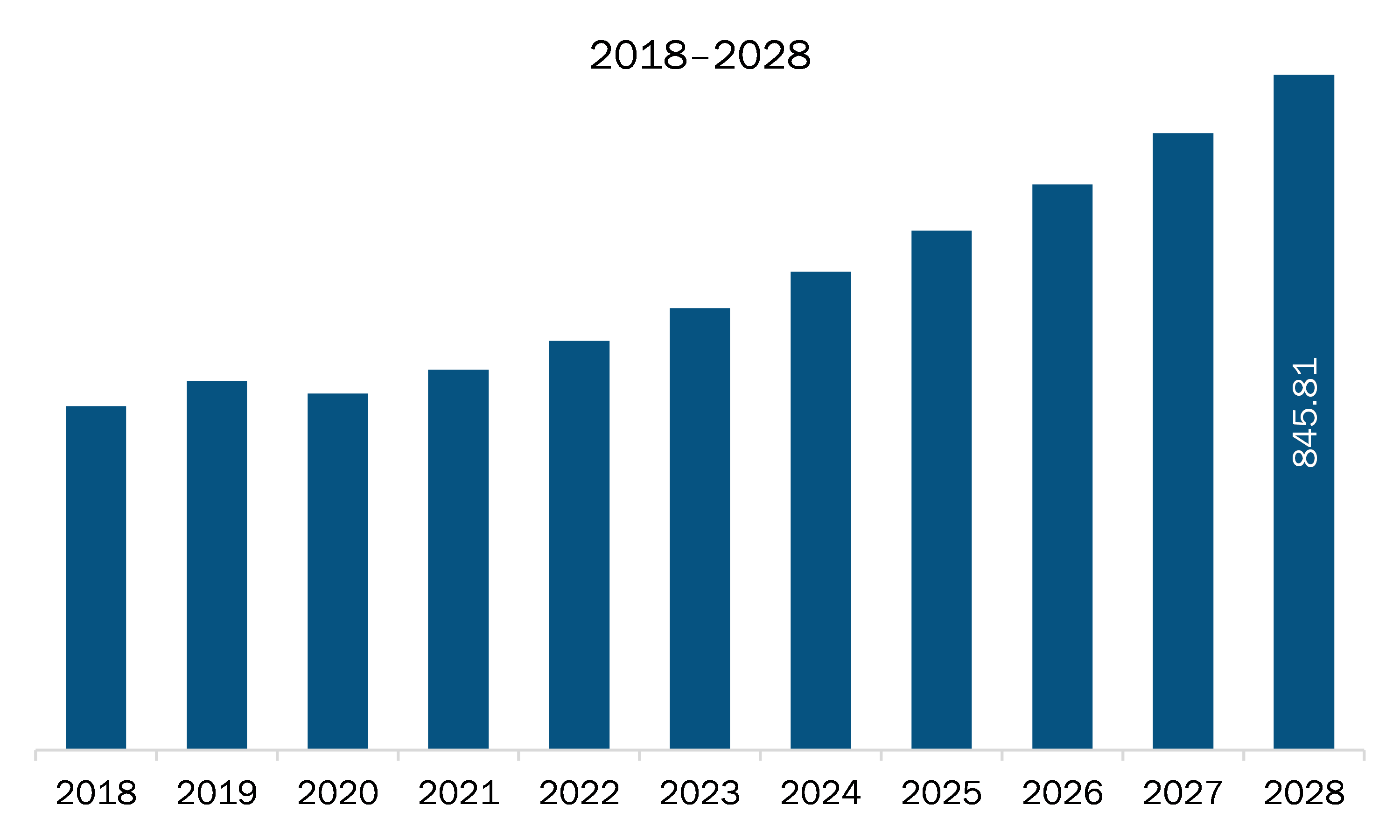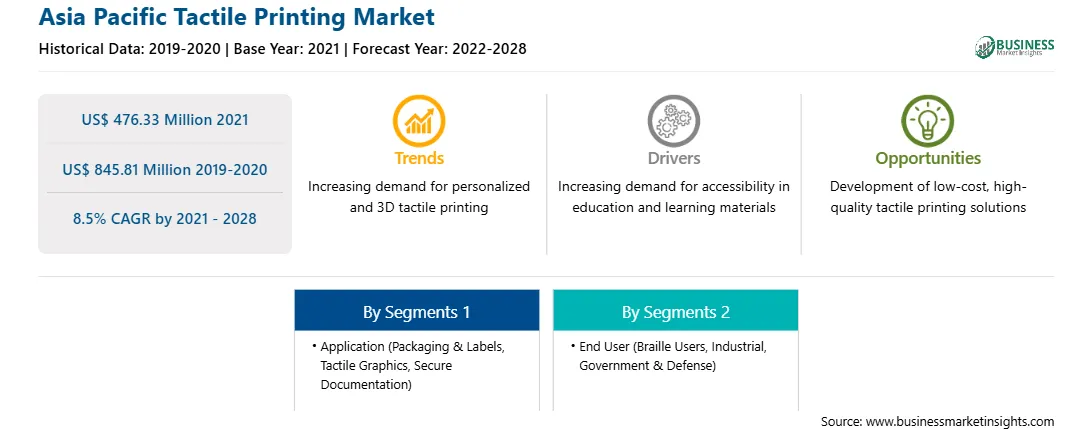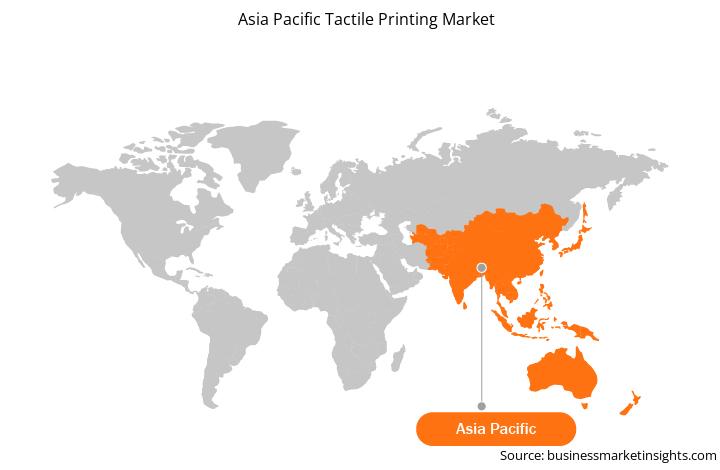APAC region include countries like China, India, Japan, South Korea, Australia, and rest of APAC. Increasing awareness about hygiene and transforming lifestyle of consumers, leading to high preference for contamination-free food, in countries such as India, China and Indonesia are stimulated developments in packaging inks and coating materials in APAC. Growing preference of consumers for tidy and attractive packaging is compelling the food &beverages, cosmetics, and pharmaceuticals brands to focus on the design and style of their packaging, which is contributing to the tactile printing market growth in this region. In addition, technological advancements are also encouraging improvements in packaging. The overall prevalence of blindness around the world is 0.7%, and ~90% of visually impaired people lives in countries such as the Philippines and Indonesia. Therefore, countries in APAC are focusing on enhancing the accessibility of services and products to people with visual impairment. Companies such as Amore Pacific and Himalayan Healthcare have developed their cosmetic product lines, which is augmenting the requirement of natural, organic, and other labels. This is eventually driving the demand for tactile printing in APAC. Also, big efforts to promote tactile graphics adoption in developing countries is the major factor driving the APAC tactile printing market.
The APAC is characterized by the presence of many developing countries, improving economies, expanding industrial sector, and huge population. The high-paced urbanization and industrialization, coupled with high investments in industrial and commercial developments, in developing countries of the region is offering ample growth opportunities to the tactile printing market players. However, the ongoing COVID-19 pandemic is causing havoc in several countries in APAC. China is considered as a leader in the packaging industry, and the economy is likely to decrease up to 50% during and after the pandemic, as the companies with their packaging facilities in China have started shifting their businesses to India. Shutdown of various plants and factories in China is affecting the global supply chains and negatively impacting manufacturing, delivery schedules, and raw material sales. In India, most label printing companies are running at as low as 15–20% working capacity, while manufacturing companies are allowed to run at 50% capacity. Accommodation of workforces, alongside ensuring physical distancing, has been a challenge, and only small percentage of companies have been able to tackle it. In addition, due to sealed borders, the procurement of raw material such as ink, label stock, plates, and dies has become difficult. Schools and universities in the region are closed amid the second wave of COVID-19. This has affected the demand for tactile graphics and Braille printed study materials.

Strategic insights for the Asia Pacific Tactile Printing provides data-driven analysis of the industry landscape, including current trends, key players, and regional nuances. These insights offer actionable recommendations, enabling readers to differentiate themselves from competitors by identifying untapped segments or developing unique value propositions. Leveraging data analytics, these insights help industry players anticipate the market shifts, whether investors, manufacturers, or other stakeholders. A future-oriented perspective is essential, helping stakeholders anticipate market shifts and position themselves for long-term success in this dynamic region. Ultimately, effective strategic insights empower readers to make informed decisions that drive profitability and achieve their business objectives within the market.

| Report Attribute | Details |
|---|---|
| Market size in 2021 | US$ 476.33 Million |
| Market Size by 2028 | US$ 845.81 Million |
| Global CAGR (2021 - 2028) | 8.5% |
| Historical Data | 2019-2020 |
| Forecast period | 2022-2028 |
| Segments Covered |
By Application
|
| Regions and Countries Covered | Asia-Pacific
|
| Market leaders and key company profiles |
The geographic scope of the Asia Pacific Tactile Printing refers to the specific areas in which a business operates and competes. Understanding local distinctions, such as diverse consumer preferences (e.g., demand for specific plug types or battery backup durations), varying economic conditions, and regulatory environments, is crucial for tailoring strategies to specific markets. Businesses can expand their reach by identifying underserved areas or adapting their offerings to meet local demands. A clear market focus allows for more effective resource allocation, targeted marketing campaigns, and better positioning against local competitors, ultimately driving growth in those targeted areas.

The tactile printing market in APAC is expected to grow from US$ 476.33 million in 2021 to US$ 845.81 million by 2028; it is estimated to grow at a CAGR of 8.5% from 2021 to 2028. Employers at small and medium-sized enterprises provide employment opportunities to a diverse range of candidates, accommodating physically disabled contenders in the workforce. Consequently, sectors such as marketing, business management and administration, human services, health science, and agriculture are extensively employing visually impaired aspirants at a large scale. Several other sectors employing visually impaired individuals include non-profit organizations; local, state, and federal governments; and self-employed entrepreneurs. Legislative changes and civil right laws also positively impact the career opportunities of visually impaired individuals. Therefore, tactile signage boards and maps are in high demand to assist these people at workplaces. Tactile graphics are also helping provide education to visually impaired populations as they may get excluded from educational, practical, and recreational information. Therefore, as per the tactile printing industry professionals, proficiency, and abundant availability of tactile graphics, coupled with advancements in related technologies, could more opportunities to visually disabled individuals to succeed in their desired fields.
The APAC tactile printing market is segmented into application, end-user, and country. Based on application, the APAC tactile printing market is segmented into packaging & labels, tactile graphics, & secure documentation. Packaging and labels segment held a substantial market share in 2020. Based on end-user, the APAC tactile printing market is segmented into braille users, industrial sector, and government & defense sector. Industrial segment held a substantial market share in 2020.
A few major primary and secondary sources referred to for preparing this report on the tactile printing market in APAC are company websites, annual reports, financial reports, national government documents, and statistical database, among others. Major companies listed in the report are American Thermoform, Canon Inc, Index Braille, Kanematsu USA, Konica Minolta, Inc., Roland DG Corporation, and ViewPlus Technologies Inc.
The Asia Pacific Tactile Printing Market is valued at US$ 476.33 Million in 2021, it is projected to reach US$ 845.81 Million by 2028.
As per our report Asia Pacific Tactile Printing Market, the market size is valued at US$ 476.33 Million in 2021, projecting it to reach US$ 845.81 Million by 2028. This translates to a CAGR of approximately 8.5% during the forecast period.
The Asia Pacific Tactile Printing Market report typically cover these key segments-
The historic period, base year, and forecast period can vary slightly depending on the specific market research report. However, for the Asia Pacific Tactile Printing Market report:
The Asia Pacific Tactile Printing Market is populated by several key players, each contributing to its growth and innovation. Some of the major players include:
The Asia Pacific Tactile Printing Market report is valuable for diverse stakeholders, including:
Essentially, anyone involved in or considering involvement in the Asia Pacific Tactile Printing Market value chain can benefit from the information contained in a comprehensive market report.